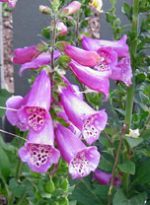 Also called lady’s glove, fairy gloves, and fairy bells, this herbaceous biennial or short-lived perennial is native to disturbed sites of Europe and Asia but naturalized in parts of North America and is considered invasive in the Pacific Northwest and parts of central and northern California.In the first year the plant produces an evergreen basal rosette of light green oblong leaves that are wrinkled and downy. In the second year it produces a one-sided raceme 3-6.6′ tall with 2-3″ inch long pendulous purple finger-like flowers with white spots inside. The flowering begins in late spring, continues for about a month and are attractive to humming birds and bees. The fruit is a capsule containing numerous tiny seeds that are attractive to birds. Plants freely reseed. Common foxglove likes part shade and average, medium moist, well-drained acidic soil in USDA Hardiness Zones 4-8.
Also called lady’s glove, fairy gloves, and fairy bells, this herbaceous biennial or short-lived perennial is native to disturbed sites of Europe and Asia but naturalized in parts of North America and is considered invasive in the Pacific Northwest and parts of central and northern California.In the first year the plant produces an evergreen basal rosette of light green oblong leaves that are wrinkled and downy. In the second year it produces a one-sided raceme 3-6.6′ tall with 2-3″ inch long pendulous purple finger-like flowers with white spots inside. The flowering begins in late spring, continues for about a month and are attractive to humming birds and bees. The fruit is a capsule containing numerous tiny seeds that are attractive to birds. Plants freely reseed. Common foxglove likes part shade and average, medium moist, well-drained acidic soil in USDA Hardiness Zones 4-8.
Fireweed (Chamerion/Epilobium angustifolium)
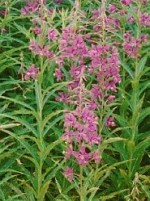 Fireweed is a rhizomatous herbaceous perennial is native to most of North America as well as Eurasia where it is found in disturbed sites such as meadows and roadsides, and is especially common after fire. Growing 2-5′ tall, it has reddish stems bearing long narrow willow-like leaves up to ten inches in length. The stems are topped by a spike of fifty or more pink, magenta or, occasionally white, flowers in summer. USDA Hardiness Zones 3-8
Fireweed is a rhizomatous herbaceous perennial is native to most of North America as well as Eurasia where it is found in disturbed sites such as meadows and roadsides, and is especially common after fire. Growing 2-5′ tall, it has reddish stems bearing long narrow willow-like leaves up to ten inches in length. The stems are topped by a spike of fifty or more pink, magenta or, occasionally white, flowers in summer. USDA Hardiness Zones 3-8
Scouleri corydalis (Corydalis scouleris)
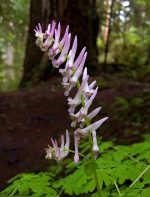 Scouler’s corydalis is a herbaceous perennial native to Washington and Oregon where it forms colonies in moist woodlands, and along shaded streambanks and shaded moist roadsides. Plants grow 20-50″ tall and have hallow stems usually bearing three large bluish leaves that are finely divided into oblong leaflets. In late spring, 15-35 pink, rose, or bicolored flowers appear in a long narrow spike. Each flower is about 1′ long and has long somewhat curved spurs that point upward and outward. USDA Hardiness Zones 6-7
Scouler’s corydalis is a herbaceous perennial native to Washington and Oregon where it forms colonies in moist woodlands, and along shaded streambanks and shaded moist roadsides. Plants grow 20-50″ tall and have hallow stems usually bearing three large bluish leaves that are finely divided into oblong leaflets. In late spring, 15-35 pink, rose, or bicolored flowers appear in a long narrow spike. Each flower is about 1′ long and has long somewhat curved spurs that point upward and outward. USDA Hardiness Zones 6-7
Mountain Hollyhock (Iliamna rivularis)
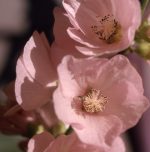 Also called streambank wild hollyhock mountain globemallow, this herbaceous perennial is native to western North America east of the Cascade Range, from British Columbia and Alberta to Montana and south to Oregon, Colorado, and Nevada where it grows on sunny mountain streambanks, subalpine meadows, roadsides, and open forest slopes at altitudes of 4,500 to 11,000′ . Growing from a woody caudex, plants grow 3-6′ tall and have stout grooved stems carrying large, five to seven-lobed palmate leaves that are broadly heart-shaped and have toothed margins. In summer loose to dense racemes of white to pink flowers 2′ across appear and each flower consists of five clawed petals surrounding a central column of fused white stamen filaments, and style topped by head-shaped stigmas. USDA Hardiness Zones 4-8. Photo Credit: Wikipedia
Also called streambank wild hollyhock mountain globemallow, this herbaceous perennial is native to western North America east of the Cascade Range, from British Columbia and Alberta to Montana and south to Oregon, Colorado, and Nevada where it grows on sunny mountain streambanks, subalpine meadows, roadsides, and open forest slopes at altitudes of 4,500 to 11,000′ . Growing from a woody caudex, plants grow 3-6′ tall and have stout grooved stems carrying large, five to seven-lobed palmate leaves that are broadly heart-shaped and have toothed margins. In summer loose to dense racemes of white to pink flowers 2′ across appear and each flower consists of five clawed petals surrounding a central column of fused white stamen filaments, and style topped by head-shaped stigmas. USDA Hardiness Zones 4-8. Photo Credit: Wikipedia
Checkerbloom (Sidalcea malviflora)
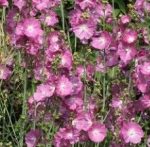 Checkerbloom is a herbaceous perennial native to western North America from Alberta and British Columbia south to Nevada, Colorado, and Oregon where it grows in prairies, subalpine meadows, chaparral , coastal sage scrub, roadsides and similar habitats. The basal leaves are rounded, lobed and up to three inches across while the stem leaves are palmately lobed with five to seven smooth segments. The lilac to pink and rose flowers have five petals, are one to two inches across, and are carried in loose terminal racemes on stout stems during the summer. The plants grow from woody crowns that can be divided in the fall when they die out in the center. USDA Hardiness Zones 5-7
Checkerbloom is a herbaceous perennial native to western North America from Alberta and British Columbia south to Nevada, Colorado, and Oregon where it grows in prairies, subalpine meadows, chaparral , coastal sage scrub, roadsides and similar habitats. The basal leaves are rounded, lobed and up to three inches across while the stem leaves are palmately lobed with five to seven smooth segments. The lilac to pink and rose flowers have five petals, are one to two inches across, and are carried in loose terminal racemes on stout stems during the summer. The plants grow from woody crowns that can be divided in the fall when they die out in the center. USDA Hardiness Zones 5-7
Blue Vervain (Verbena hastata)
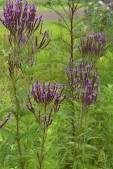 This clump forming perennial, also known as marsh vervain, is native to most of the United States where it grows in moist soils such as wet meadows, river bottoms, marshes, and ditches. The plant is erect, may branch in the upper half, and forms colonies by means of slow growing rhizomes and self-seeding. The stems are red or green, four angled, and bear narrow leaves six inches long and one inch across. Each leaf is conspicuously veined and has coarsely toothed margins. The small purple flowers are produced atop terminal stems in densely packed inflorescenes that look like candelabra and open a few at a time from bottom to top over a long bloom time. The flowers attract many different insects including bees and butterflies, and the seeds that follow attract songbirds. USDA Hardiness Zones 3-8
This clump forming perennial, also known as marsh vervain, is native to most of the United States where it grows in moist soils such as wet meadows, river bottoms, marshes, and ditches. The plant is erect, may branch in the upper half, and forms colonies by means of slow growing rhizomes and self-seeding. The stems are red or green, four angled, and bear narrow leaves six inches long and one inch across. Each leaf is conspicuously veined and has coarsely toothed margins. The small purple flowers are produced atop terminal stems in densely packed inflorescenes that look like candelabra and open a few at a time from bottom to top over a long bloom time. The flowers attract many different insects including bees and butterflies, and the seeds that follow attract songbirds. USDA Hardiness Zones 3-8
Purple Dragonhead (Physostegia parviflora)
This herbaceous perennial is also called western false dragon head is native to Manitoba to British Columbia, south to Illinois, Utah, and Oregon where it grows in marshes, streams and lake margins in lowlands and montane zones. Plants have a rhizomatous root system and simple or branched 4-angled stems 8-40″ tall. The sessile leaves are linear and up to 4′ long with pointed tips and finely toothed margins. In summer, terminal and axillary spikes 3/4″-3″ long of white, pink or lavender flowers appear.